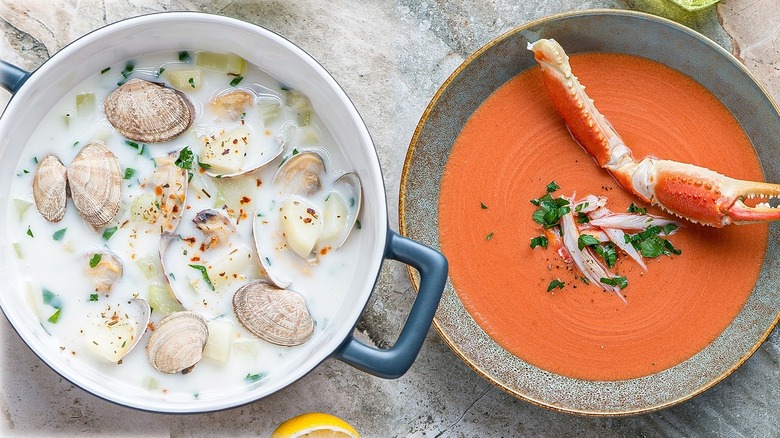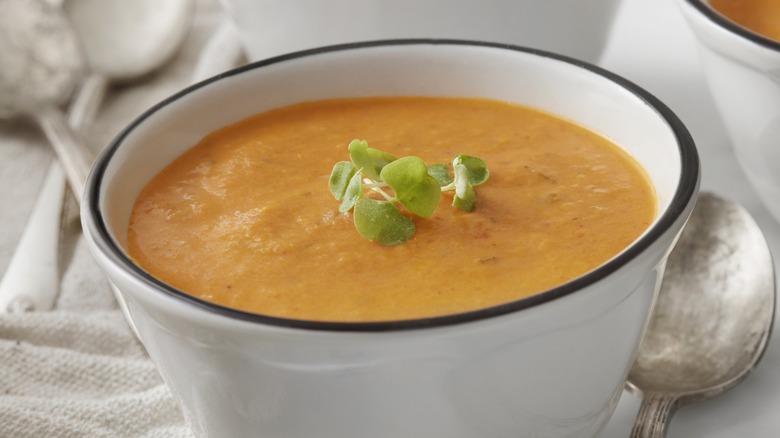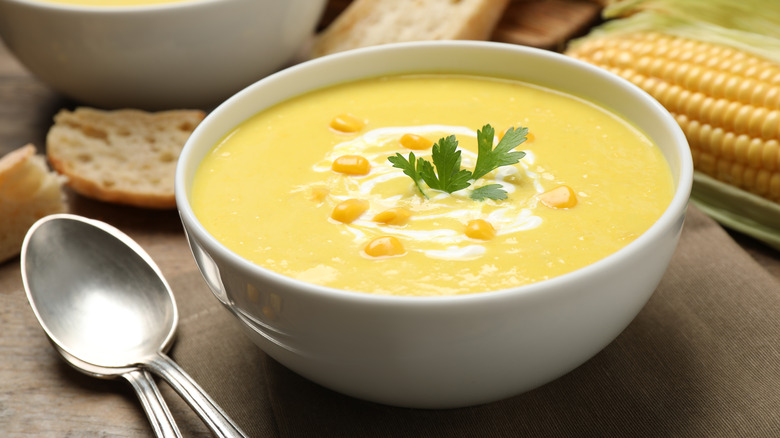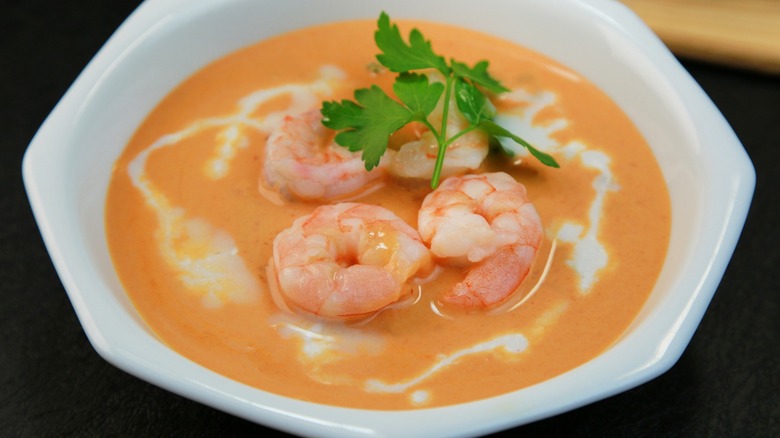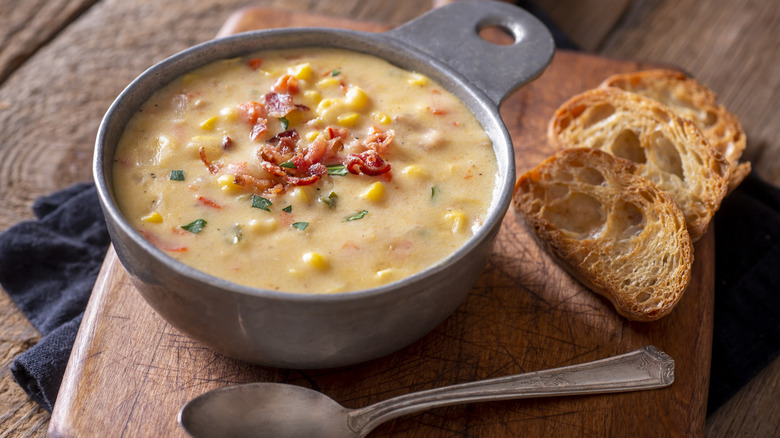The Main Difference Between Chowder And Bisque
"Seinfeld" fans won't soon forget "The Yada Yada" episode, in which Elaine names the lobster bisque as the best part of a dinner date she went on. It's hilarious, but not because it's a joke at bisque's expense — it's hilarious because foodies know that bisque is that good. It's so good that bisque is low-key as famous on the screen as it is on the menu.
In an episode of "A Cook's Tour," the late great Anthony Bourdain visits his alma mater, the esteemed Culinary Institute of America, where a class of new cooking students is cutting their chops by learning to make flavorful stocks. Indeed, making a knockout stock is essential to the kitchen, because soups really are that big of a deal, and a good meal without a good soup is just a meal.
That's why, today, we're deep-diving into two of the most crave-able subcategories of soup: bisque and chowder. Both are seafood-centric and cream-based, but foodies wouldn't mistake one for the other when they arrive at the dinner table. The defining difference between the two varieties is the texture. Bisques are smooth and velvety, while chowders are chunky and loaded with large, hearty pieces of ingredients — and that's just the beginning.
What is chowder?
According to the authority at Merriam-Webster, "chowder" is "a soup or stew of seafood (such as clams or fish) usually made with milk or tomatoes, salt pork, onions, and other vegetables (such as potatoes)." Cambridge Dictionary similarly calls chowder "a type of thick soup usually made from fish or other sea creatures." So, by these definitions, what makes a soup a chowder solely has to do with the ingredients — but these parameters don't paint the full soupy picture. Chowders are gastronomic hodgepodges by nature, so it's not just about which ingredients are used, it's about how they're incorporated. In the chowder realm, large chunks are the name of the game.
Chowder is a rich soup loaded with big, toothy pieces of ingredients. Potatoes, fish, carrots, corn, ham, onions, and other assorted dense veggies are common. Chowders are always chunky and always creamy (like this creamy corn and chicken chowder) ... at least, almost always. The one exception to the rule might be Manhattan clam chowder, which trades the cream broth for a puréed tomato base. Some of the most popular chowder varieties are clam chowder, Southwest corn chowder, and funky New England fish chowder (a favorite dish of former U.S. President John F. Kennedy).
What is bisque?
In the traditional French preparation, bisque is typically made from some sort of seafood base such as lobster, crab, or shrimp. For such an elevated dish, it calls for thrifty, zero-waste prep, using the crustaceans' meat in the soup and steeping their cleaned-out shells into a flavorful stock. Old World French chefs even used to grind the bodies of the crustaceans into powder, then turn it into a paste that would be used to thicken the body of the bisque.
This labor-intensive process has largely fallen out of popularity in modern kitchens. However, thickeners like rice or cream-based roux are still used to retain that rich body (which can also help when making non-seafood bisques like butternut squash, mushroom, and tomato bisque). Gourmands can spot a bisque by its puréed texture.
Many bisque recipes include wine or heavy cream (or both) to help the broth achieve bisque's signature silky, luscious mouthfeel and light acidity. White wine, sherry, and brandy are not uncommon ingredients for bisques, but you're unlikely to find them in chowders. Some bisques swirl the cream into each serving bowl at the end rather than incorporating the cream into the larger batch of bisque and adding it earlier in the cooking process. Bisques sometimes also include hot melted butter for an extra creamy finish.
Bisque is smooth and chowder is chunky
The primary difference between bisque and chowder is that chowders are hearty, warming, and stew-adjacent, whereas bisques are lighter. By contrast, bisque is more closely related to consommé, a strongly flavored French style of clarified broth-like soup. Cooks of yore used to pass their bisques through a hand-cranked food mill to achieve that signature smooth texture, but nowadays, an immersion blender or food processor can purée that lovin' bowlful much quicker. In other words, you might serve a bisque as an appetizer, but a chowder is an entrée (or at least a substantial side dish).
Chowders are sometimes thickened with crushed-up biscuits or crackers, on top of already being loaded with chunks of seafood, vegetables, and cream. In bisques that use meat at all, the meat is added at the end to serve as a garnish, whereas in chowders all the ingredients are stirred together into one hearty mixture. Bisques can also be served hot or chilled, while chowders are almost exclusively served hot. Even though bisques with perishable ingredients need to be fully cooked to be safe to eat, the final serving temperature is sometimes reduced at the end as in chilled shrimp bisque, chilled tomato bisque, chilled corn bisque, and the more avant-garde dessert-like chilled strawberry bisque.
Bisque is a French thing
Another key difference between bisque and chowder is that bisque is a French style of soup. The word "bisque" is thought to have derived from the Bay of Biscay, an inlet of the North Atlantic Ocean that touches the coast of western France and northern Spain. The Bay of Biscay is known for its lush fishing industry, which provides a wealth of wild-caught fish and oysters. In classic French bisques, the meat is cooked separately and used as a topping to further showcase its quality, as in the French soupe de poisson (a favorite dish of the aforementioned Anthony Bourdain that's flavored with saffron, orange, fennel, and licorice-y Pernod).
In the bisque-y beginnings, working-class French fishermen commonly made a soup called "chaudiere," named after the large common cauldron in which an assortment of fish and seafood scraps were combined and simmered at the end of a day's work into a hearty, flavorful patchwork chowder. It wasn't until the 1700s that bisque rose from the tables of home cooks in local fishing communities to the apex of haute French cuisine. Even in the contemporary dining sphere, bisque remains a connotatively fancy dish — an ornament of fine dining — whereas chowder is considered a more accessible, even utilitarian, lower-class dish.
Chowder's roots are American ... pretty much
To say that chowder is exclusively American might not be exactly accurate, but chowder has certainly taken on a life of its own with different evolutions as a regional dish in the U.S. In the American Northeast, chowder commonly includes some combination of scallops, cod, smoked salmon, clams (basically whatever type of seafood is fresh and available in the unique geographic area), and potatoes. A classic New England chowder, for instance, features salt pork, potatoes, onions, and some sort of fish or shellfish, all married in a creamy evaporated milk stock.
In the Southwest, chowders are typically corn-forward and loaded with a kaleidoscope of flavorful spices, like this chipotle corn chowder recipe. Rather than seafood, the protein is often bacon, ham, chorizo, or chicken. Vegetarian chowders (which don't belong to any one particular region — a soup without a country, if you will) can be loaded with bulky, hearty veggies like mushrooms, parsnips, carrots, sweet potatoes, or winter squash. Within these parameters, there are (of course) delicious crossovers like crab and corn chowder (which are very welcome, in our book. Call it the Great American Melting Pot or whatever).
However, the matter of chowder's regionality becomes a bit complicated when foodies take a glance further back into soupy history at how chowder arrived on U.S. shores in the first place. Chaudiere might have come to the seafaring American Northeast colonies along with French settlers, and according to some historians, the word "chowder" might have etymological roots in the French "chaudiere."
